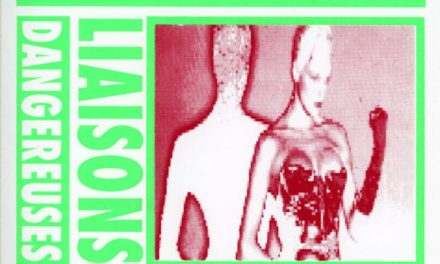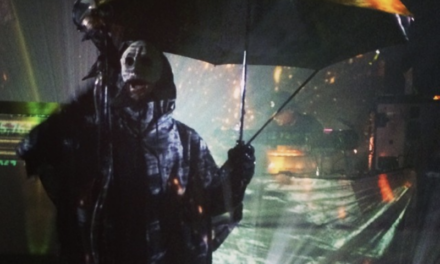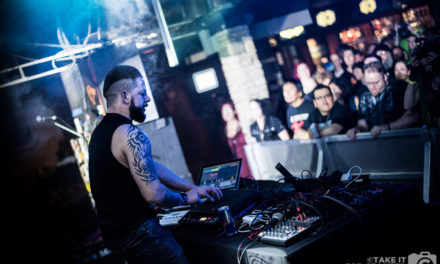We’re happy to feature a full report from Martin Eigengrau on “Die Zukunft findet nicht mehr statt”, Hypnoskull’s performance piece at the final Maschinenfest. We talked a bit about Hypnoskull’s longer legacy a couple of months back, and were intrigued by the video and photos we saw of the performance trickling out of Maschinenfest. Let’s get to Martin’s take on Hypnoskull’s audacious performance.
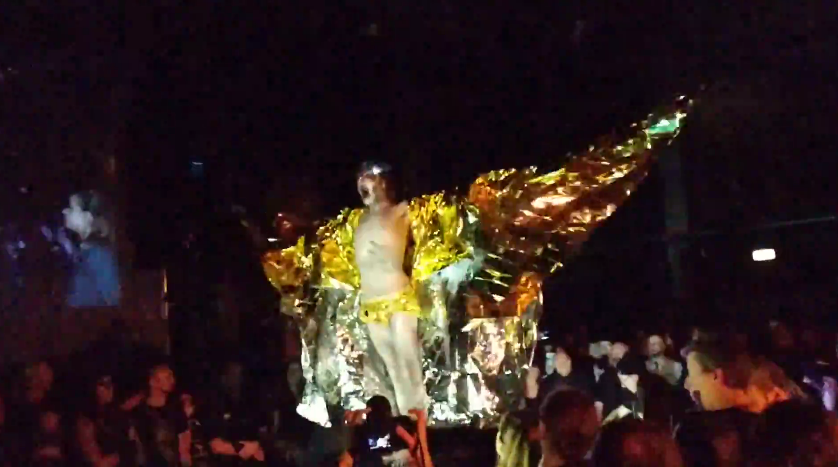
I.
At the moment the performance is supposed to start, the stage is empty: No artist, no equipment. It is Sunday night at the final Maschinenfest which has been throwing an incredible lineup at the audience for two and a half days now with machine-like precision and flawless organization. Hypnoskull is the 27th artist supposed to play, and the irritation as the rhythm of the festival is interrupted is immediate.
But then, suddenly, projected on a screen that fills the entire stage, is a man wearing a business suit and a balaclava, standing somewhere outside, facing the camera, starting to talk into a microphone. Even in the first moments of confusion, we register that this seems to be a live broadcast, not something prerecorded. He addresses the audience, reading some kind of manifesto in an urgent tone. All this is happening very fast, and amidst the general confusion, it is hard to follow his speech – something about how we don’t have a clue what is going on, about this period of change, about the angel of history, about fascism happening in the name of progress, and Die Zukunft findet nicht statt, as he briefly switches to German.
In the meantime, some of us have figured out that he must be outside the back of the hall, so we start to run there – just in time to see a big door open, the guy walking in, accompanied by the camera crew (still streaming everything to the big screen), some security folks and people pushing in a goddamn car. That car looks like something out of Mad Max, with the hood full of sound equipment, a mess of gold and silver foil on the roof and yes, there is a skull.
The strange little convoy makes its way through the bewildered audience, stopping somewhere in the middle of the hall. Hypnoskull (Patrick Stevens himself, supported by Dutch producer Kubus) jumps out and start playing, right there, with all the stuff on the car.
We are still trying to take in all the details, turning heads between the spectacle in front of us and its larger-than-life reproduction on the giant screen – when the mess of metallic foil on the cars roof suddenly starts to move, unfolds like a pair of wings, and there he stands on the roof of the car: the angel (Raachid Lachir), pale and nude except for some foil around his waist. His arms outstretched, his foil-wings shaking and flattering in an invisible wind, weak and ecstatic.
II.
At this moment, what is happening at the Turbinenhalle has already been transformed from the ritualized concert experience into something far less predictable. But this has only been the prelude, and the whole thing takes another unexpected and violent turn as a couple of security guards (performers Audrey Apers and Jan Deboom) start to attack the angel, beating him down from the car, tearing at his wings. He neither fights back nor tries to escape, just endures it. As he loses his first wing, he manages to climb up on the car again, once more spreading his remaining wing to the cheers of the audience. But that doesn’t last for long, as the assault continues. During the following twenty minutes, the angle is beaten down again and again, pushed to the ground, his wings completely torn away. Sometimes, it seems like the attackers are almost embracing him, maybe nursing him back to just enough strength so that they can further degrade him. At one point, a bottle of champagne is opened and forcefully poured into his mouth, and some audience members also get their share. At another point, the female attackers leads audience members to the almost unconscious angel, instructing them to kiss his hands, in a gesture that seems like a twisted version of religious devotion.
At least once, someone from the audience tries to intervene and protect the angel and is forced back.
And during all the time, Hypnoskull is operating their sound equipment, that dangerous looking mess of knobs and cables on the hood of the car, providing a soundtrack of distorted beats and deafening noise.
When the angel finally stops moving all together and is carried out of the hall by the security guards, the whole tension that has built up during the performance is released. We dance and rave around the fucked-up car, in the puddle of champagne, in the half-dark of the Turbinenhalle. It feels completely wild and anarchic, there is not separation between audience and stage, just the pagan horde around the industrial shamans and their totemic car.
III.
On a pure visceral level, what Hypnoskull did was an incredible success. It was completely unexpected and unpredictable, it felt urgent and dangerous, it built up and released immense tension in the audience, it was a performance that I am sure will be talked about for years. However, when trying to figure out what they were actually trying to communicate, what the message was (if there was one), we felt pretty lost.
A valuable hint was given on Hypnoskull’s Facebook page, where Patrick calls it “A performance based upon the ‘Angelus Novus’ monoprint by Paul Klee and the essay that was written about it by Walter Benjamin.” The essay in question is part of Benjamins Theses on the Philosophy of History – the last major work of the German Jewish philosopher which he wrote shortly before his suicide in 1940, on his flight from the Nazis. The passage in question reads as follows:
A Klee painting named Angelus Novus shows an angel looking as though he is about to move away from something he is fixedly contemplating. His eyes are staring, his mouth is open, his wings are spread. This is how one pictures the angel of history. His face is turned toward the past. Where we perceive a chain of events, he sees one single catastrophe which keeps piling wreckage upon wreckage and hurls it in front of his feet. The angel would like to stay, awaken the dead, and make whole what has been smashed. But a storm is blowing from Paradise; it has got caught in his wings with such violence that the angel can no longer close them. The storm irresistibly propels him into the future to which his back is turned, while the pile of debris before him grows skyward. This storm is what we call progress.
Trying to use this as a key to decipher the performance, however, leaves me scratching my head once more: If it was the Angel of History we saw beaten, who were the attackers? Fascists? Did the forceful removal of his wings mean he is no longer blown away by the storm that we call progress? Would it allow him to stay in the present and start his healing work? I clearly recognize the motives, but can’t get the symbols and metaphors to match up.
The initial manifesto that may have provided some context was dropped at us fast and without warning, so nobody was really able to follow it. In the meantime however, the new Hypnoskull album The Manichaean Consciousness has been released, and a text that comes with it is probably the manifesto from the performance – I can’t say for sure if it is exactly identical, but I recognize enough passages to know that it is at least a variation of it.
this is not an apology. this is a statement. an attempt to not suffer in these times of violent dualism. the era of the false glorification of the so called reason and the well thought over argument. the era where some of us believe we can fight opponents by using the pen, the argument, the thought. how i wish i could agree with them. how i wish the opponents would have the exact same spirit. yet they don’t.
This initial statement is clearly a taking the stance on a question that has become more urgent during the last two years: How do you deal with rising fascism, and with the fascists using the rights provided to them by an open society to attack this very openness?
I’ll leave it to the reader check out the rest and dive deeper into it. There is a desperate struggle to communicate that which can’t be put into words – I have no idea how to use all the words in such a manner they don’t end up being distorted by connotations – in these thoughts about fascism and dissidents and internalized oppression. It reminds me that the human impulse to reduce complex experiences to a single clear message is often a trap. “Die Zukunft findet nicht statt” as performed at Maschinenfest was maybe a better manifestation of a struggle that is both internal and external, both historical and personal, than any text by Hypnoskull or some random witness’ account could ever be.
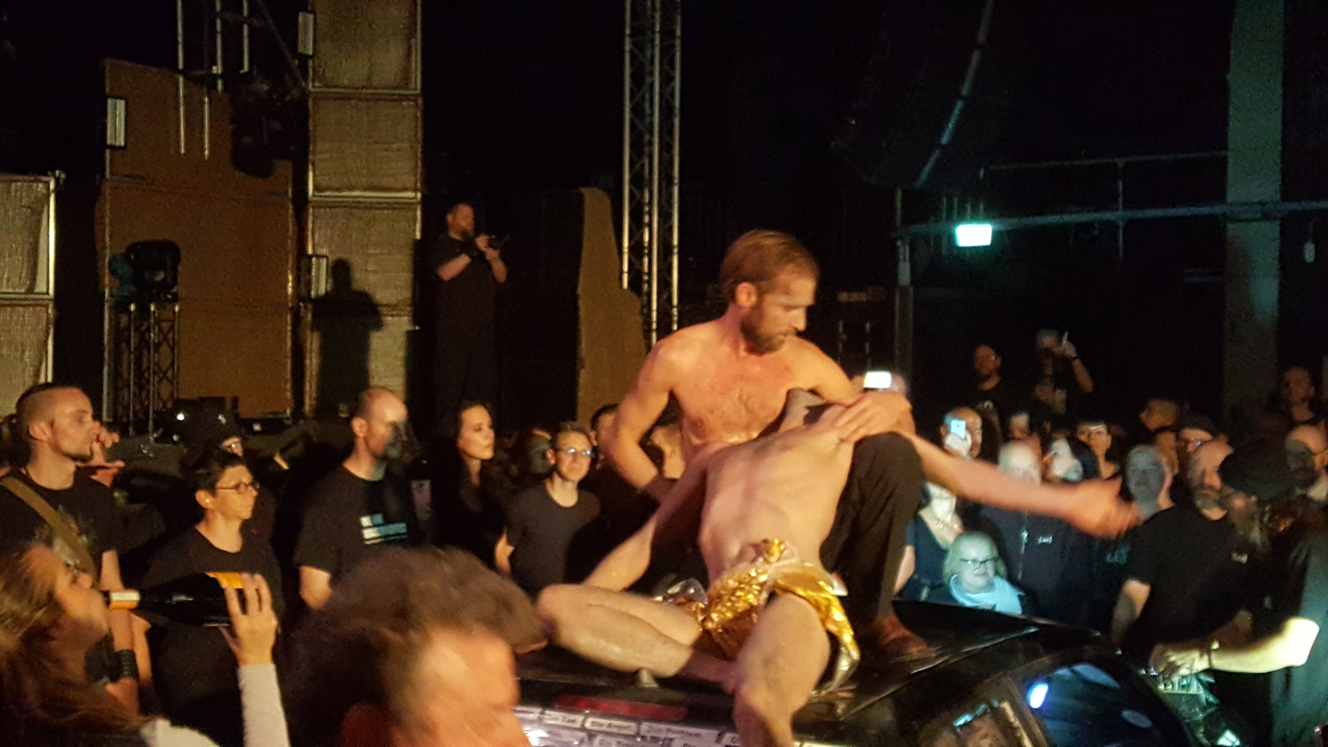
IV.
It would be easy to dismiss the whole thing for its lack of clear message. It would be easy to criticize it for flaws in execution or conception. It would be easy to make fun of it, because it is always easy to make fun of people who do something strange, like standing on a car and pretending to be an angel.
But to me, none of that matters. Patrick Stevens and his co-conspirators went all in on this. There was nothing half-hearted, no holding back or playing it safe. Raachid Lachir was there, a vulnerable and almost naked angel. Audrey Apers and Jan Deboom where there, playing the bad guys, face to face with a crowd whose reaction to their performance was uncertain. Hypnoskull was there, playing a kick-ass set, with all the equipment on that car, right in the middle of the audience which, at some point, stopped being a mere audience. There was no safety net, no distance, no fear of making a fool of themselves. It was in many regards the most fearless performance I have witnessed in a long time, and it delivered a hopeful glimpse into the potential for disruption that still exists within a genre that in many regards has become ‘just another style of music’.
And it was the perfect high note on which to end the Maschinenfest tradition.


